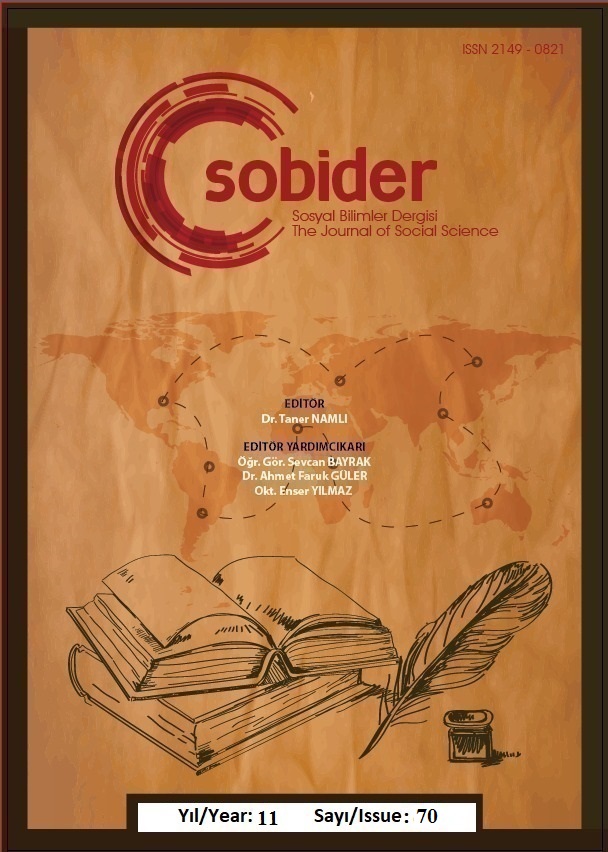Author :
Abstract
Alacakaya Doğu Anadolu Bölgesinin Yukarı Fırat bölümünde yer alır. İdari olarak Elazığ iline bağlıdır. İlçenin tarihi burada çıkarılan zengin krom yataklarının bulunması ile başlar. Krom yatakları 1935 yılında bulunmuş, çıkarılan kromun işlenmesine ise 1936 yılında başlanmıştır. Ayrıca ilçede mermer ocaklarının işletilmesiyle birlikte 1990-2000 yılları arasında bir nüfus artışı görülmektedir. Ancak krom madeninin ilçe nüfusuna etkisi kadar büyük bir nüfus artışı göstermemiştir. Bu nedenle bu çalışmada Alacakaya ilçesinin nüfus özellikleri demografik analiz yöntemi ile ele alınmıştır. Alacakaya’nın engebeli arazi üzerine kurulması nüfusun sahada yayılmasını engellemiştir. Nüfusun sahada yayılışını engelleyen yüksek dağlık kütleler vardır. 1990 yılından günümüze kadar ki süreç içerisindeki nüfus sayıları göz önüne alındığında şehir nüfusu ile köy nüfusu arasındaki fark düzenli olarak azalmıştır. İlçeye bağlı 10 köy bulunmaktadır. İlçe tarım sektöründe çalışan nüfusun çoğunluğunu kadınlar, sanayi ve hizmet sektöründe çalışan nüfusun çoğunluğunu ise erkekler oluşturmaktadır. Alacakaya ilçesinde doğumlar ve ölümler nüfusun olağan seyrine çok etki etmemiştir. Nüfusun günümüze kadar azalmasında göçün etkisi büyüktür. Ülkemizde başlayan köyden kente göç hareketine Alacakaya ilçesi de katılmıştır. İlçedeki mevcut ekonomik koşulların iyi olmaması, istihdamın azlığı, eğitim ve sağlık koşullarının elverişsizliği, merkeze uzaklığı, engebeli yapısı, mevcut iklimi, terör olayları gibi nedenlerden dolayı ilçe düzenli olarak göç vermiştir. Bu durumun sonucunda, 1990 yılından günümüze kadar seçim dönemlerindeki geçici artışlar dışında nüfus sürekli azalmıştır.
Keywords
Abstract
Alacakaya is located in the Upper Euphrates section of the Eastern Anatolia Region and is administratively affiliated with Elazığ province. Our study addresses the population characteristics of Alacakaya district. The fact that Alacakaya was established on a rugged terrain prevented the population from spreading in the area. There are high mountainous masses that prevent the population from spreading in the area. The history of the district center begins with the discovery of rich chrome deposits here. The chrome deposits were discovered in 1935 and the processing of the extracted chrome began in 1936. With the opening and operation of marble quarries in the district, a population increase was observed between 1990 and 2000. However, it did not show a population increase as great as the effect of the chrome mine on the district population. When the population numbers in the period from 1990 to the present are considered, the difference between the city population and the village population has decreased steadily. There are 10 (ten) villages affiliated to the district. The majority of the population working in the agricultural sector of the district is women, while the majority of the population working in the industrial and service sectors is men. Births and deaths in Alacakaya district have not affected the normal course of the population much. The effect of migration on the decrease in the population until today is great. Alacakaya district has also participated in the migration movement from villages to cities that started in our country. Due to the current economic conditions in the district being bad, lack of employment, poor education and health conditions, distance to the center, rugged structure, current climate, and terrorist incidents, the district has regularly emigrated. As a result of this situation, the population has continuously decreased from 1990 to the present, except for temporary increases during election periods.





